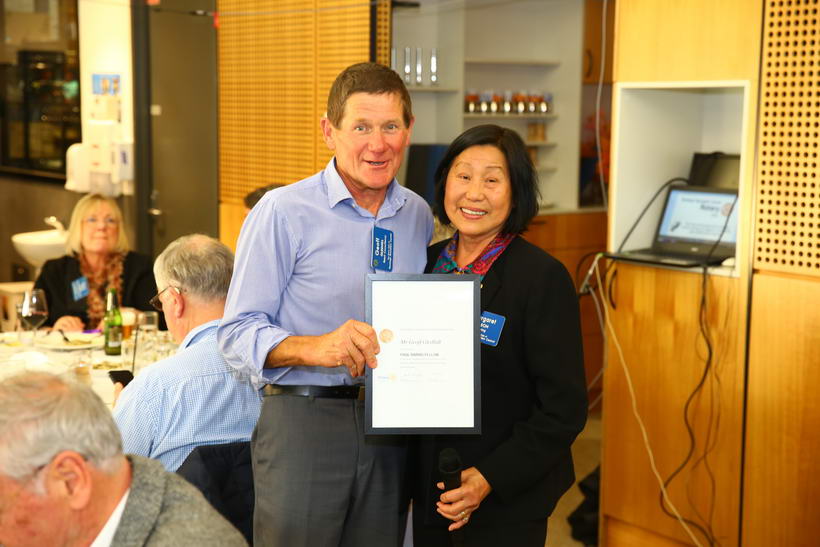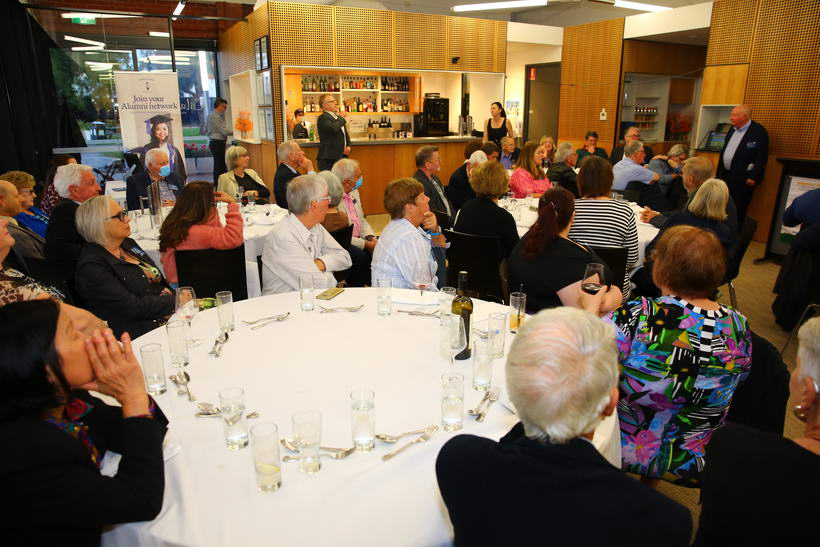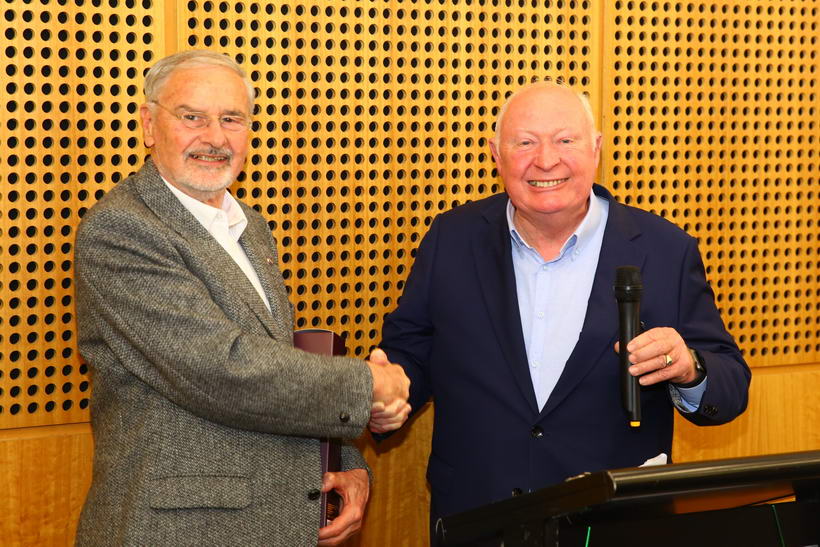
- Tim L was chairperson for this week’s club meeting which was an evening meeting at Cilantro, with a full house of club members, partners and many guests. Partners included Asia, Angie, Leonie, Julie, Helen, Sarah, Angela and Gary. Friends and guests included Russell and Ian (friends of Neville), Chris (Pres of Beaumaris R.C.), Greg and Cathy Every (Beaumaris R.C.), Cassie and Rosemary (Helen’s family from Canberra), Michaela (friend of Julie Reid), a guest of Sue Loeliger, Jonas, and Jenny Le Marshall. My apologies if anyone has been missed.
- Larry performed Invocation and Tony performed the Loyal Toast.
PAUL HARRIS FELLOW RECOGNITION
- It was great to catch up with Past President Geoff Gledhill who has been unable to attend meetings in recent times. Finally we have caught up with him and more importantly, he was presented with a Paul Harris Fellow Recognition in recognition of his two years as club president 2019 – 2021. Congratulations Geoff and well deserved.
PRESIDENT ANNOUNCEMENTS – President Margaret
- Birthday wishes were extended to Sue Loeliger and Leonie Ryan
- Club Meeting Wednesday 7/12 – a reminder this meeting will be held at Flight Deck/Aero Bar Café, 37 First Avenue, Moorabbin Airport to be followed by a tour of the Aviation Museum. Commencement time is 7.30am, with the Aviation Museum tour at 9.00am. Club members are welcome to invite partners or guests. Samantha is taking numbers for both the breakfast meeting and the museum tour.
- Club End of Year Celebration BBQ Lunch - Sunday 11/12 – is being held at the AB Rotunda area in Packer Park, Leila Road, Carnegie. Commencement time is 12.00pm. Please BYO own drinks, a folding chair and maybe a folding table as seating in the rotunda may be limited. Samantha is taking numbers for the lunch
D9810 DISTRICT CONFERENCE – Ian
- Ian reminded everyone Early Bird conference registration ends 30/11 before the registration price increases. So far 20 from our club have registered to attend.
GUEST SPEAKER – Professor John Le Marshall
- Tim L introduced Professor John Le Marshall – a person who has numerous titles and received many prestigious recognitions in the field of meteorological science. He recently retired from the Bureau of Meteorology where he joined in 1972, and was appointed as Senior Principal Research Scientist from 1974. John maintains a connection with the Bureau as a visiting scientist. In 2003, John became the first Director of the NASA, NOAA and DoD Joint Center for Satellite Data Assimilation at the World Weather Building in Maryland, USA. The Center is responsible for accelerating the operational implementation of satellite data assimilation systems in NOAA, the National Weather Service, NASA and the Department of Defence to allow exploitation of current and next generation satellites. For his work, John was awarded NASA’s highest scientific award in 2006 – Exceptional Scientific Achievement Medal – before returning to Australia and the Bureau of Meteorology in 2007. He is also a Fellow of the American Meteorological Society, and a Fellow of the Australian Meteorological and Oceanographic Society.
- John’s talk focused on weather and the role of weather satellites for predicting weather. A series of weather maps and charts were presented where John explained the detailed and technical process for reading the charts for predicting weather. 100 years ago, early weather maps and predictions relied on observations and interpretations of meteorological instrument readings taken from land points and whaling ships at sea. Improvements were gradual. The most defining moment for improving weather readings and predictions occurred in April 1960, when Tiros 1 was the first weather satellite launched by newly created NASA that transmitted images of cloud patterns over Earth and enabled identifying storm regions. Over the years many advancements have been made. In 2002, the Aqua satellite was launched and transmitted Infrared and Radiation readings with 2,300 channels receiving data for measuring temperature and atmospheric pressure. There are now more than 100 satellites transmitting weather related data whilst orbiting Earth. Obvious benefits include predicting weather for Emergency Services, forecasting fire weather, flood forecasting, weather forecasting for aviation and shipping, and other more useful day to day applications. Predictions have improved to the degree they have higher accuracy for a longer period. Work is currently underway with Forums being held and plans to launch an advanced Australian satellite.
- MEETING CLOSURE
President Margaret thanked John for his very comprehensive presentation, and closed the meeting with this year’s Rotary theme – Imagine Rotary.





